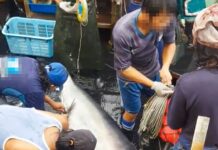By Jane Meza
Mombasa County, Kenya: Climate heating is raising the sea level and though it can be argued whether it will rise slower or faster people living along the coastal line will need to pay close attention. Coastal communities also face different issues than inland communities. These include increased risks from high-tide flooding, sea level rise, erosion which are the impacts of climate change.
Confronting existing challenges that affect man-made infrastructure and coastal ecosystems, such as shoreline erosion, coastal flooding, and water pollution, is already a concern in many areas.
Kenya Marine and Fisheries Research Institute (KMFRI) is working with climate actors to beat the harsh effects of climate change to remedy the situation along the coastal areas.
Oceans support and make the economies vibrant for the coastal communities with the various activities that they depend upon as part of the ecosystems.
 However, humans have heavily altered the coastal environment through development, changes in land use, and overexploitation of resources.
However, humans have heavily altered the coastal environment through development, changes in land use, and overexploitation of resources.
Now, the changing climate is imposing additional stresses, making life on the coast more challenging and consequently the ripple effect will be felt in the entire country, which depends on the productivity and vitality of coastal regions.
Historical sites and landmarks such as the Fort Jesus Museum, the entire Old Town of Mombasa with its countless historical locations including the Mandry mosque and Allidina Visram High School, the Old British Customs House, the Vasco da Gama pillar in Malindi, the Lamu Islands, and nearly all populated coastal towns along the Kenyan Coastline run the risk of being submerged due to the ensuing sea-level rise.
The historical sites are tourist destinations and a source of livelihood for the coast people who depends on while on the other hand heritage sites have significant cultural, historical, and economic values to play but are at risk worldwide due to the drastically effects of climate change.
It is against this background that KMFRI is working to remedy the situation by planning a Long-term change in temperature and weather patterns commonly known as Ocean heating which might be caused by natural processes or human activities.
While Climate change is real and we see its effects clearly now but since the 1800s, human activities caused by combustion of fossil fuels like coal, oil, and gas is believed to be the primary cause of climate change and with the continuity of human activities around the globe, the climate has been on the receiving end resulting in negative results globally.

The rise of sea levels and ocean water acidification negatively affect the Kenyan coastline, heritage, and the coastal community at large. Coastal residents largely depend on the ocean for livelihood, and a sick ocean puts their lives in deferred.
Marine ecosystems are being threatened by climate change and ocean acidification. The oceans are absorbing more carbon dioxide as the concentration in the atmosphere increases, resulting in ocean acidification, which threatens coral reefs and shellfish. Coastal fisheries are also affected by rising water temperatures and climate-related changes in oceanic circulation.
Thousands of families in the lowland coastal areas face the risk of being displaced by flooding occasioned by the rise of sea levels and other climate change consequences where they are forced to relocate to safer grounds.
The marine ecosystem has not been spared from adverse high temperatures that have risen by 0.14° Fahrenheit (0.08° Celsius) per decade from the year 1880 when accurate record keeping was introduced.
According to researched done by National Oceanic and Atmospheric Administration, 2021 was recorded as the sixth-warmest year on record, based on NOAA’s temperature data. High temperatures in the marine ecosystem lead to loss of marine life forcing the migration of marine species from one habitat to another to increase their chances for survival.














